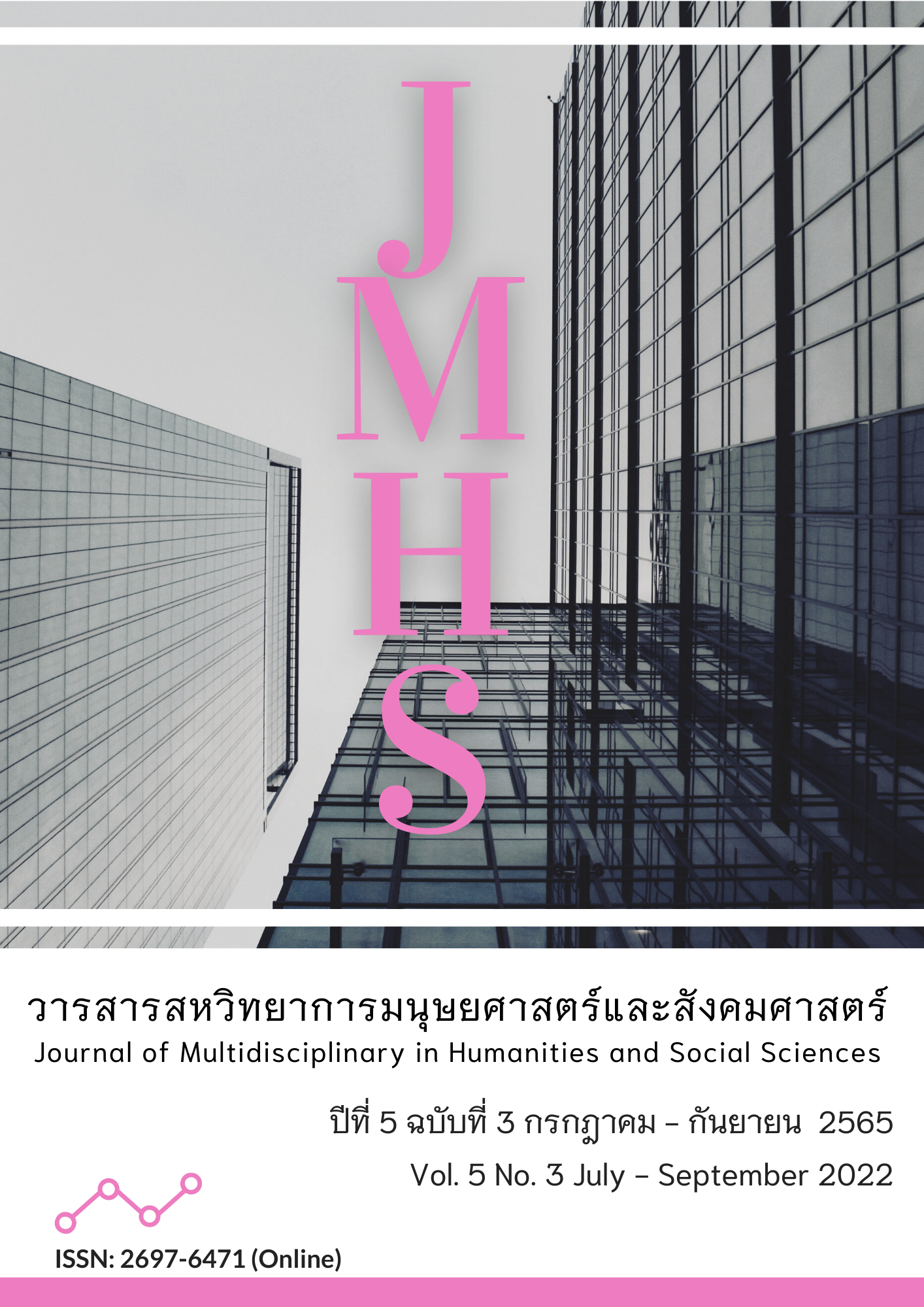The Development of Reading Comprehension Ability of Prathomsueksa 6 Students taught by Using the Theory of Multiple Intelligences with Graphic Organizers
Main Article Content
Abstract
This article aimed to 1) compare the reading comprehension abilities of Prathomsueksa 6 students before and after learning management using the theory of multiple intelligences with graphic organizers; and 2) study Prathomsueksa 6 students’ opinions toward instruction using the theory of multiple intelligences with graphic organizers. The sample used in this study was composed of 15 Prathomsueksa 6/1 students from Wathongrattanaram School, Wat Arun, Bangkok Yai, Bangkok, who were studying in the 1st semester of academic year 2021. Simple random sampling was conducted by drawing lots with classrooms as random units. This experimental research has one sample group and a pre-test and a post-test. The instruments used in this study were lesson plans using the theory of multiple intelligences with graphic organizers; a reading comprehension test; and a questionnaire on the students’ opinions toward instruction using the theory of multiple intelligences with graphic organizers. The data was analyzed by mean (M), standard deviation (SD), and dependent samples t-test. Analysis data by descriptive statistics and content analysis. The research results were found as follows:
1. The reading comprehension ability of the Prathomsueksa 6 students taught by using the theory of multiple intelligences with graphic organizers was significantly higher than before studying at the .01 level.
2. The Prathomsueksa 6 students’ opinions toward instruction using the theory of multiple intelligences with graphic organizers were at a high agreement level.
Based on the aforementioned research results, teachers should have proactive learning activities that focus on learners in accordance with different aptitudes and differences of learners. To develop reading comprehension or other abilities continually for effective learning management.
Article Details

This work is licensed under a Creative Commons Attribution-NonCommercial-NoDerivatives 4.0 International License.
Views and opinions appearing in the Journal it is the responsibility of the author of the article, and does not constitute the view and responsibility of the editorial team.
References
กมลรัตน์ ภวภูตานนท์, สมทรง สิทธิ และ อนุวัต ชัยเกียรติธรรม. (2559). การเปรียบเทียบผลสัมฤทธิ์ทางการเรียนความสามารถในการอ่านจับใจความและเจตคติต่อการเรียนวิชาภาษาไทยระหว่างการจัดกิจกรรมการเรียนรู้ตามแนวทฤษฎีพหุปัญญากับการจัดกิจกรรมการเรียนรู้ตามแนวคิดสมองเป็นฐานของนักเรียนชั้นมัธยมศึกษาปีที่ 1. วารสารช่อพยอม, 27(2), 93-101.
กรมวิชาการ กระทรวงศึกษาธิการ. (2540). หลักสูตรก่อนประถมศึกษา พุทธศักราช 2540. กรุงเทพฯ: โรงพิมพ์คุรุสภาลาดพร้าว.
จิตรลดา คำนวณสิน. (2557). การพัฒนารูปแบบหนังสือวรรณคดีไทยอิเล็กทรอนิกส์แบบเชื่อมโยงร่วมกับโซเชียลมีเดียตามทฤษฎีการตอบสนองของผู้อ่าน เพื่อส่งเสริมความเข้าใจในการอ่านของนักเรียนชั้นประถมศึกษา. วารสารอิเล็กทรอนิกส์ทางการศึกษา, 9(4), 1-12.
จุไรรัตน์ ลักษณะศิริ และ จีรวัฒน์ อินทรพร. (2556). ภาษาไทยเพื่อการสื่อสาร. นครปฐม: โรงพิมพ์มหาวิทยาลัยศิลปากร.
ฐิตินันท์ บุญเสริม และ สุรชา อมรพันธุ์. (2562). การเปรียบเทียบผลสัมฤทธิ์ทางการเรียนวิชาคณิตศาสตร์ ความสามารถในการคิดวิเคราะห์และเจตคติต่อวิชาคณิตศาสตร์ เรื่องระบบจำนวนเต็ม ของนักเรียนชั้นมัธยมศึกษาปีที่ 1 ระหว่างการจัดการเรียนรู้ตามแนวทฤษฎีพหุปัญญาและการจัดการเรียนรู้แบบกลุ่มร่วมมือ. วารสารมนุษยศาสตร์และสังคมศาสตร์ มหาวิทยาลัยราชภัฏมหาสารคาม, 13(2), 249-260.
ทิศนา แขมมณี. (2550). รูปแบบการเรียนการสอนที่หลากหลาย. กรุงเทพฯ: สำนักพิมพ์แห่งจุฬาลงกรณ์มหาวิทยาลัย.
ไพรินทร์ พึ่งพงษ์ และ บุษบา บัวสมบูรณ์. (2557). การพัฒนาผลสัมฤทธิ์ทางการอ่านและเขียนสะกดคําที่มีสระประสมของนักเรียนชั้นประถมศึกษาปีที่ 1 โดยใช้ยุทธวิธีพหุปัญญาแผนผังความคิดและแบบฝึกเสริมทักษะ. Veridian E-Journal, Silpakorn University (Humanities, Social Sciences and arts), 7(2), 662-674
มลิวัลย์ ลับไพรี. (2549). ความรู้เบื้องต้นเกี่ยวกับเด็กฉลาดและเด็กที่มีความสามารถพิเศษเฉพาะทาง. กรุงเทพฯ: จุฬาลงกรณ์มหาวิทยาลัย.
วนิษา เรซ. (2550). อัจฉริยะสร้างได้. กรุงเทพฯ: ซีเอ็ดยูเคชัน.
สถาบันทดสอบทางการศึกษาแห่งชาติ. (2562). ผลการทดสอบระดับชาติขั้นพื้นฐาน (O-Net). สืบค้นจาก http://www.niets.or/th
สำนักงานคณะกรรมการการศึกษาขั้นพื้นฐาน. (2551). หลักสูตรแกนกลางการศึกษาขั้นพื้นฐาน พุทธศักราช 2551. กรุงเทพฯ: กระทรวงศึกษาธิการ.
สุจริต เพียรชอบ และ สายใจ อินทรัมพรรย์. (2538). วิธีสอนภาษาไทย ระดับมัธยมศึกษา. กรุงเทพฯ: ไทยวัฒนาพานิช.
อารี สัณหฉวี. (2550). สอนภาษาไทยแนวสมดุลภาษา. กรุงเทพฯ: สมาคมเพื่อการศึกษาเด็ก
Buzan, T. (1997). The Mind Map Book: Radiant. London: BBC Book.
Gardner, H. (1983). Frame Of Mind: The Theory of Multiple Intelligences. New York: Basic Books.
Yussof, M. et al. (2012). Enhancing Reading Comprehension through Cognitive and Graphic Strategies: A Constructivism Approach. Social and Behaviral Sciences, 64(70), 151-160. DOI:10.1016/j.sbspro.2012.11.018


